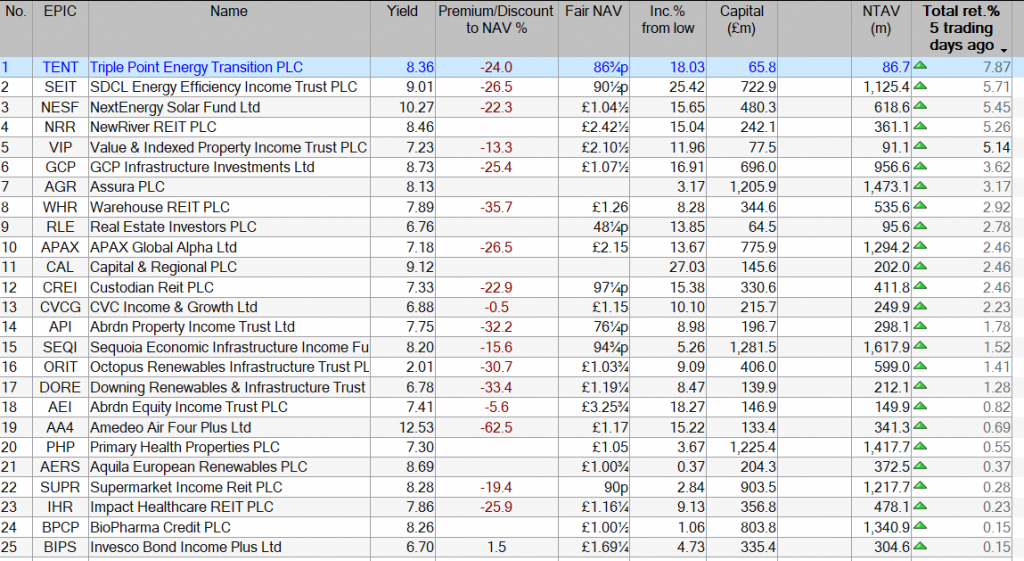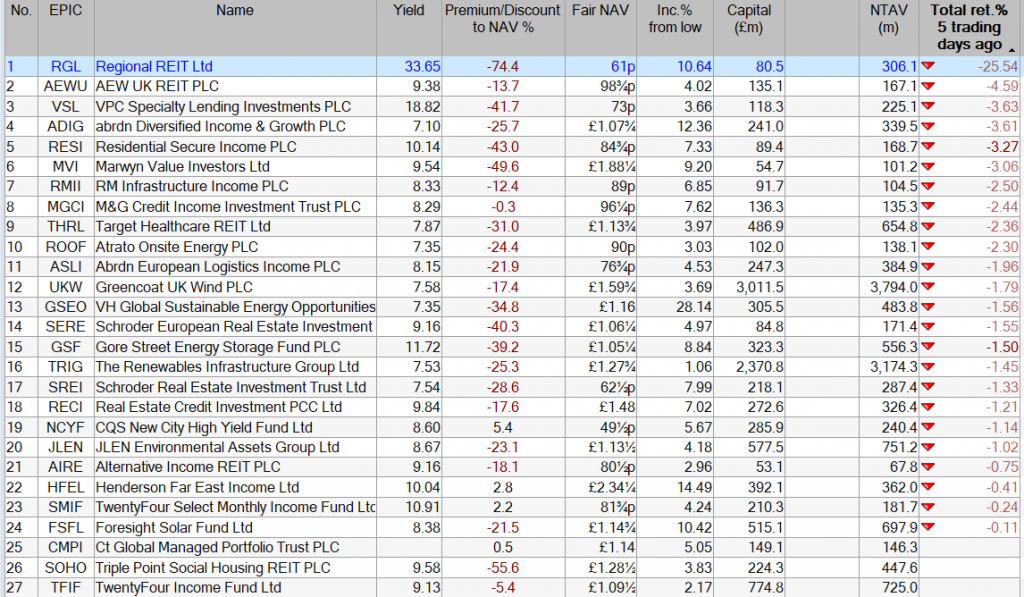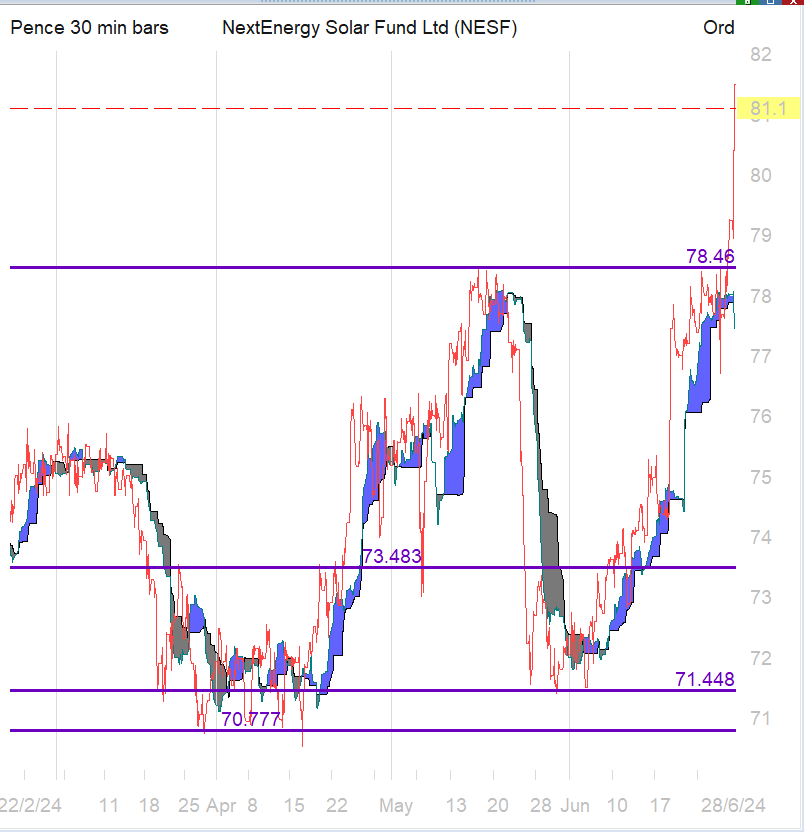The Results Round-Up – The Week’s Investment Trust Results
Which fund has reported NAV per share increases for every reporting period since the Company’s IPO in 2018? And which fund almost called it a day during its latest financial year?

By Frank Buhagiar

Patria Private Equity (PPET), the fund formerly known as abrdn Private Equity Opportunities
PPET’s +2% half-year NAV total return was trounced by a +22.9% share price total return (dividends reinvested). Chair Alan Devine believes ‘the buyback programme introduced by the Board in January 2024 has helped to support the improved performance of the share price.’ With the FTSE All-Share up just +6.9%, the fund’s share price total return has now outperformed the index over 1, 3, 5 and 10 years. Mention in despatches from the Chairman here for the ‘investment strategy, which has remained consistently focused on partnering with a focused cohort of high-quality private equity firms, predominately in the European mid-market.’ Name may have changed but strategy remains the same.
Investec: ‘Patria Private Equity (PPET) has a clear philosophy and proven approach. PPET focuses on partnering with a concentrated list of leading private equity firms and the core focus is the European mid-market. Since IPO in 2001, the excess annualised NAV total return versus the MSCI Europe index is 5.3%. However, despite this outstanding achievement, the discount remains stressed. We believe this represents excellent value and enhances a strong fundamental proposition.’
Numis: ‘The shares currently trade on a c.28% discount to our estimated NAV, which we believe, along with several other stocks in the LPE sector offers value.’
CC Japan Income & Growth (CCJI) hoping for more of the same
CCJI new Chair June Aitken had a relatively easy first half-year statement to write. NAV and share price total returns clocked in at +19.5% and +19.7% respectively compared to the TOPIX’s +14.9% sterling total return. The Chair believes ongoing structural and governance reforms, the end of deflation and the country’s technological prowess make ‘a compelling case for long-term investment into Japanese equities.’ No doubt, Aitken will be hoping future results statements will be just as easy to write.
Winterflood: ‘Semiconductor-related companies were strong performers in recognition of their industry leading positions and as potential beneficiaries of global realignment.’
JPMorgan Global Core Real Assets (JARA) being proactive
JARA’s full-year NAV total return may have come in at -4.4% but in local currency terms underlying asset performance was +0.3%. Transportation (+1.6%) and infrastructure (+1.6%) helped to offset real estate (-3.2%). A widening in the share price discount to NAV to 30.5% from 14.9% hit the shareholder total return (-20.9%) but post-period end, the discount has narrowed to -19.1%. Just as well for, as Chairman John Scott explains, ‘When our discount was above 35%, serious consideration was given to recognising that JARA’s offering was not finding favour with investors and that the best outcome for shareholders might be a dissolution of the Company’. A close-run thing then.
Progress made maybe but Scott and his fellow ‘Directors are committed to addressing JARA’s discount to NAV through proactive measures’. One of these is, subject to FCA and shareholder approval, reducing ‘JARA’s exposure to real estate and recycle this capital into other sectors, such as transport and infrastructure, where we expect stronger risk adjusted returns.’ The Board believes these changes should generate ‘Higher yields which in turn ‘should lead to increased dividends.’ That should go down well with shareholders ahead of the upcoming continuation vote.
JPMorgan: ‘Since the August 2023 AGM, JARA has bought back 11,887,814 shares (5.4% of the then shares in issue) resulting in 1.3% accretion to NAV per share.’
Augmentum Fintech (AUGM) keeps record intact
AUGM posted a +5.4% NAV per share increase for the full year. According to Chairman Neil England ‘This continued our history of increases for every reporting period since the Company’s IPO in 2018.’ England thinks there’s more to come. As well as improving inflation numbers, healthy cash reserves (£44.8 million as at 31 May 2024), ‘The underlying need to digitalise and transform financial services remains. Penetration is still only c.5% across the industry although adoption of consumer-focused fintech by younger demographics is markedly higher.’ It’s all about the demographics!
Numis: ‘Augmentum Fintech has a unique mandate among London-listed funds, focused on European fintech companies, which are seeking to disrupt the business models of traditional banking and financial services. We believe that the fund may be an attractive long-term investment, albeit that the early-stage nature of the companies means that it may not always be a smooth ride for investors.’
Sequoia Economic Infrastructure Income (SEQI), cautiously optimistic
SEQI’s full-year NAV total return came in at +8.1%. That beats the 7-8% target. At 6.875p per share, total dividends also met the previously raised target too. No wonder Chairman James Stewart described the results as ‘another resilient year of performance.’ The Chairman puts forward three reasons behind the resilience: being ‘agile’; focusing on the credit quality of the infrastructure debt portfolio; and continuing market demand. Not all plain sailing. Share price is stuck at a discount to net assets. The Board however ‘continues to address this proactively against the challenging market backdrop.’ What’s more CEO Randall Sandstrom sees ‘reasons for cautious optimism’ – inflation is falling, interest rates should soon follow, so too market default rates. Hallelujah!
Liberum: ‘We continue to view SEQI’s as amongst the most attractive alternative funds in the current environment.’
The Global Smaller Companies’ (GSCT) year of two halves
GSCThad a strong second half of the year. Just as well, for at the half-year stage NAV total return was -6.3%. By year end, NAV total return stood at +9.0%. Not quite enough to match the benchmark’s +11.3% but the shareholder total return did better, up +12.7%. Looking ahead, Chair Anja Balfour doesn’t appear to be losing too much sleep over ongoing economic/geopolitical concerns. That’s because ‘Our Manager will continue to focus on identifying companies that will do well regardless of what happens in the wider economy.’
Winterflood: ‘Asset allocation positioning hurt relative performance over the year, largely reflecting UK overweight and North America underweight.’
Bankers’ (BNKR) looking to concentrate more
BNKR’s +17.5% NAV and +21.5% share price total returns for the half year trumped the FTSE World’s +16.6%. No sitting on laurels though. During the period, a strategic review was undertaken. The result? The number of the fund’s regional portfolios is falling from six to four: North America, Pan Europe (to include the UK), Pan Asia (ex-Japan) and Japan. While smaller holdings are being chopped because these ‘were not improving performance. We therefore intend to increase the amount of capital in our best ideas by reducing the number of holdings towards 100.’
Numis: ‘We believe that it makes sense to reduce the number of holdings given the limited impact the tail end of the portfolio is likely to have on performance with an increased focus on the ‘best ideas’, although note that the number of holdings remains relatively high.’
SDCL Energy Efficiency Income (SEIT) remaining cautious
SEIT reported a 90.5p NAV per share as at 31 March 2024. That’s down on last year’s 101.5p. The headline number doesn’t tell the whole story as NAV per share barely moved in the second half. So, most of the fall occurred in the first half of the year as the discount rate was increased in response to the ‘higher for longer’ inflation/interest rate backdrop. The company isn’t standing still waiting for things to improve: selective disposals are being made; borrowings reduced; while a capital allocation policy has been adopted to ensure ‘returns on any new investment compare favourably with any alternative opportunity’. As CEO Jonathan Maxwell writes ‘Particularly where interest rates remain relatively high, we remain cautious.’
Liberum: ‘There is enough potential in the longer-term equity story for us to think it makes sense for SEIT to be valued at a narrower discount than most of its peers. This is one of the more distinct strategies in the sector in that it invests in operating companies, providing the greatest scope for long-term EBITDA and ultimately NAV growth.’
Schroder UK Mid Cap (SCP) doing a spot of fishing
SCP’s +9.3% NAV return for the half year, a little off the benchmark’s +11.4%. Chair Robert Talbut blames the fund’s growth focus. The period under review saw ‘a sharp and fast rotation within the mid-cap universe away from long-term growth businesses towards more interest rate sensitive businesses linked to the interest rate cycle which typically have more stretched balance sheets and challenged business models.’ Still, SCP has consistently outperformed over five and ten years. No surprise then that Talbut believes ‘focusing upon quality will continue to deliver over time.’
The investment manager meanwhile ‘would like to remind readers that we are fishing in an attractive pond. The mid 250 is populated by multiple ‘unique’ companies with strong growth prospects generating cash and delivering attractive returns on capital.’
Winterflood: ‘Share price TR +5.8% as discount widened from 12.0% to 15.2%; no shares repurchased.’








